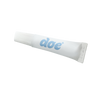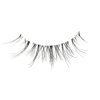We all love the look of longer, fuller lashes, and we’ve proven we’ll do practically anything to get them. This includes sitting in a salon chair for hours on end while a trained professional superglues individual lash fibers to our natural lashes, using magic eyelash lengthening serums that can potentially cause skin discoloration, and attaching false eyelash strips to our lids with glues that contain some chemicals that are pretty unfriendly to our skin and eyes. No matter what, we just want gorgeous lashes, no matter the consequences.
The problem with these methods of eyelash enhancement is not only the potential risks, but also the cost. Especially when considering eyelash extensions, you can easily spend upwards of $500 a month maintaining them. Serums, too, can cost over $100 per bottle and usually only last around a month.
Because of the issues surrounding eyelash extensions and serums, the industry standard has always been false eyelash strips. Nothing creates more glamour, more volume, and more length, more instantaneously than a great set of strip lashes. Unlike lashes of the past, strip lashes today are super lightweight, comfortable, effortless to apply and remove, and stay where they’re put, if you’re using the correct eyelash glue.
Eyelash Glue: What Kinds Are There?
You can find a tube of eyelash glue practically anywhere. Type “eyelash glue” into your search engine and you’ll get millions of hits. But not all eyelash glue is created equal. In fact, many eyelash glue formulas can even be harmful to your eyes.
Eyelash glues can typically be categorized into three different groups. These groups classify eyelash glues based on how they are formulated; i.e. what makes them stick. Within these groups are numerous other options for your glue; think tinted glues, clear glues, etc.
- Rubber Latex Adhesive Glue. This is the OG eyelash glue that has been used for decades, although formulas today have been updated to weed out at least some ingredients that can be harmful. Rubber latex glues are easy and cheap to manufacture, and provide adequate bond to most any type of lash band. These glues are known for producing long-lasting grip that is easy to remove and won’t damage your lash fibers.
The problem with rubber latex adhesive glues, however, is that you’re definitely not going to find a hypoallergenic formula. In fact, so many people suffer from latex allergies that for a product to be considered hypoallergenic, it cannot contain latex.
Additionally, almost all rubber latex eyelash glues contain formaldehyde. This is a known carcinogen, which means it is scientifically linked as a possible cause for cancer in human beings. Regardless of how little formaldehyde a tube of eyelash glue may contain, there’s no way we want to risk it near our face.
- Surgical/Medical Grade Glue. What could be better than attaching your false eyelashes to your eyelids with glue intended to close wounds on an operating table? Those lashes would never come off, right? Wrong. First off, we like false eyelashes because we can easily apply and remove them whenever we want. Although we want a glue that holds, we don’t want a glue that rips our skin off with the eyelash band. Second, the terminology used to market these types of glues is pure hype. You won’t find a tube of this stuff on any surgeon’s tool tray.
Surgical or “medical grade” glue simply means the glue has the ability to move with your skin. Much like the glue that surgeons actually do use to close incisions, this glue can bond and hold with a certain elasticity that allows your skin to move more comfortably without breaking the bond.
The problem with these types of glues is that the formulations are newer, which means they haven’t been tested as thoroughly. That leaves the door open for numerous users to get eye infections, and suffer through irritations and allergic reactions before the glue actually gets taken off the market. As such, using this kind of glue can kind of make you feel like a lab rat.
- Hypoallergenic/Organic Formulas. Our favorite glues that are available fall into this category. We aren’t saying you can’t find a glue you love that’s medical grade or rubber latex, but for ease of use, bond longevity, and overall safety, hypoallergenic glues are totally our jam.
These glues can even be found in all-natural formulas, although there is definitely a weaker bond with an all natural glue than with one that is simply hypoallergenic. In fact, you may find that a hypoallergenic glue doesn’t hold as long overall compared to its rubber latex cousins, so essentially it really comes down to what your eyes can tolerate and what you are willing to use on your skin.
While many hypoallergenic glues claim to be “formaldehyde free,” it should be noted that they actually can contain a trace amount of this chemical, as regulated by the FDA. If you really want to know what’s in your eyelash glue, use a reputable third-party testing agency to find out what ingredients are included.
How Can I Make an Eyelash Glue Work Best?
Ensuring your eyelash glue holds properly and does its job correctly really starts by making sure you’re buying high-quality false eyelash sets. Some eyelash sets attach their fibers to bands made of synthetic materials like polyester. Not only are these bands heavy and pokey, they don’t adhere to the glue as well as a 100% cotton band.
Here at Doe Lashes, we always use a 100% cotton band, so no matter what kind of glue option you choose, you can be sure that if your lashes aren’t adhering, it’s not because of the band. Our bands are also always created to be as thin as possible, so that our lashes look super natural. Nothing is worse than a visible false eyelash strip band. Because of the extremely thin band, you’ll definitely want to make sure the glue you choose has an appropriate applicator. Some glues come with a small brush, which makes application very easy and allows you to really control how much glue gets on the band.
You can get the most hold out of your glue by applying it correctly. Here’s how to apply your eyelash glue so that it holds as long as possible.
- Use a brush. If your eyelash glue didn’t come with a fine tip applicator, or if too much glue squeezes out of the tube, consider using a very thin eyeliner brush (or even a thin paintbrush) to apply the glue to your lash band.
- Use an applicator tool. Unless you’re just really good at applying lash glue, there’s a real risk you can get the glue on the fingertips of the hand holding your lash band, which almost always means the glue will end up in the lash fibers. This can create a huge mess, potentially wreck your lashes, and cost you valuable clean up time. Avoid it altogether by using a simple eyelash applicator tool. Hold your lash strip with the tool in one hand and apply the glue with the other. This eliminates any chance that the glue will go anywhere but the lash band.
- Apply a thin line of glue. You can always add more, but you can’t take any away. Start by applying an extremely thin line of glue. Remember that less is always more, and glue is usually formulated to take hold and bond tight.
- Allow the glue to rest on the lash band for 15-30 seconds. This will allow it to dry down just enough and become tacky, so that when you apply your false eyelash strip to your natural lash line, the lash will set in place immediately, we promise. The glue will hold even after you let it dry a few seconds.
- Apply your eyelash band. Using the applicator tool, press the band onto your natural lash line according to your lash manufacturer’s instructions. For a quick and easy tutorial on how to apply your Doe Lashes like a pro, click here.
- Let it dry. You should let your lash glue dry for a few minutes before heading out for the day. Once you think it’s dry, give the lash band a small tug in the middle to ensure it has bonded correctly. If not, don’t get frustrated, it just means you need a little more practice. After a few tries, you’ll be able to apply lashes that refuse to move.
False eyelashes define beautiful, dramatic eyes, and the best way to get them is by using false eyelash strips and a high quality eyelash glue. It’s important to make sure that your eyelash strips are made from materials that allow glue to adhere properly. Eyelash bands made of polyester or other synthetic fabrics don’t allow glue to adhere as well as cotton bands.
Eyelash glue is extremely effective, bonds tightly to your eyelash strip and to your eyelid, and can keep your lashes safely in place for hours. Be sure to check the ingredients of your eyelash glue to look for known eye irritants. If you have sensitive eyes or simply want to go the organic route, look for hypoallergenic formulas that are free of harsh chemicals.
Sources:
https://www.fda.gov/cosmetics/cosmetic-ingredients/latex-cosmetics
https://www.cancer.org/cancer/cancer-causes/formaldehyde.html


